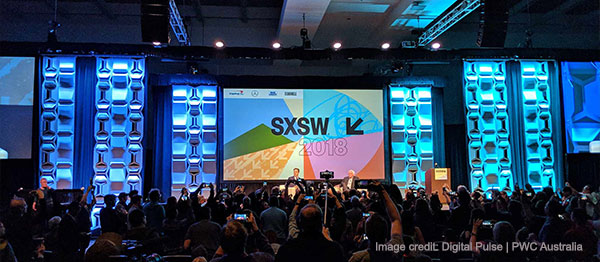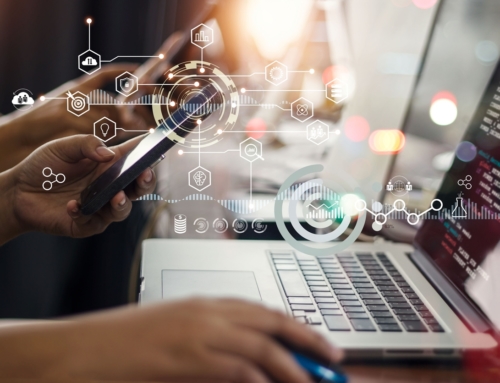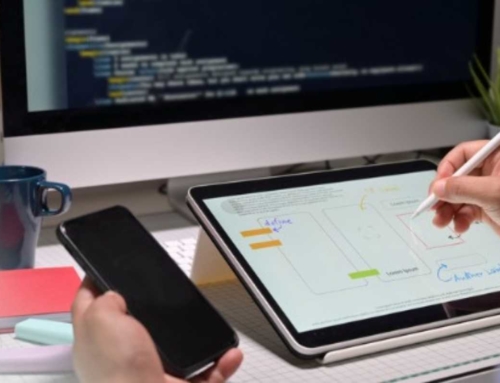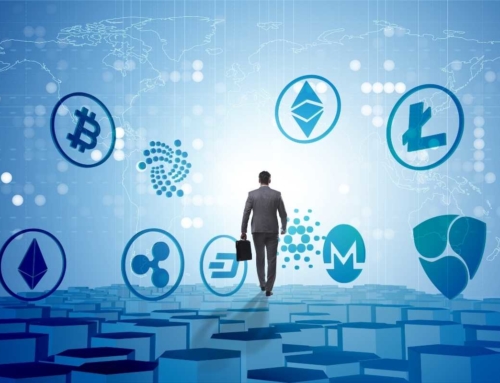It is a beautiful and terrifying thing to be in Austin, Texas for the first half of March every year. Almost 500,000 people flooded the streets of Austin last month to participate in SXSW 2018.
South by Southwest, or “South-by” to the locals, is the “world ‘s largest creative business conference and festival” according to Inc. Magazine. It also just so happens to be in the backyard of the Woz U creative team. This was an opportunity that we could not pass up to report upon.
A Good Problem to Have
When an innovation conference takes over an entire city, there are an overwhelming number of sessions and panels and things to do: Tech, music, film, gaming and wellness–OH MY!
For SXSW 2018, our content team looked over the sessions and selected some we thought would make the most sense to us and the Woz U community — career-minded big dreamers looking to transition into more tech-focused roles.
I ‘m not going to lie when I say that I have always been a little intimidated by people in the tech stratosphere. In my mind, I get into a conversation with someone who has just built a tool to help reduce ambulance response rates and I will not have anything to add to the conversation except genuine admiration and questions like “What connected you to this mission?” and “How can I help?” My advice to a fellow innovation amateur is this: don ‘t let that stop you!
SXSW is not a tech conference for newbies by any means. Attendees and panelists alike can all mingle at the afterparty and speak the same language, if you will. Tech acronyms like ‘SaaS ‘ ‘NoSQL ‘ are dropped in conversation like beats at a Kanye show. It can be pretty daunting. But here is my trick … When you are in the mix and feel like everyone else is discussing numerical nuances in advanced calculus while you ‘re still making small talk about multiplication tables: be confidently curious. Then, not only will you not be left in the dark, you ‘ll be able to turn on the light for others.
So I entered into these SXSW 2018 sessions confidently curious: Ready to ask the questions that tested their ability to explain a complex topic to a 10-year-old, or you know 32-year-old-me. In the upcoming recaps, I define terms like machine learning (ML), virtual reality (VR), and artificial intelligence (AI) and hear from experts on how technology is helping shape everything from how we get the weather in the A.M. to weather or not we should change the course of our career path to create impact in new industries. Industries liiiike data science, software development and well, I don ‘t want to spoil it … READ ON!
Day 1 of SXSW 2018
The Future of Machine Learning – Worth the Hype?

Panelists L to R: Chris Jones, Finale Doshi-Valez, Jeff Chow and Tom Foster
Machine Learning defined: Machine learning explores the study and construction of algorithms that can learn from and make predictions on data. These algorithms are built to overcome program instructions, or “learn” to make data-driven predictions or decisions. Professionals that use machine learning in their day-to-day and are looking to inform future business decisions, weigh in on whether or not ML lives up to its reputation from the news and mouths of influencers like Elon Musk of Tesla and Jeff Bezos of Amazon.
Panelists:
Jeff Chow – VP of Product – TripAdvisor
Finale Doshi-Valez – Asst. Professor of Computer Science – Harvard University
Chris Jones – VP of Technology – iRobot
Tom Foster – Moderator – Editor at Large – Inc Magazine
Session Takeaways:
- The rate of technology is accelerating faster than we have people who can interpret the data.
- We need more data scientists and software developers to advance their knowledge on coding [link to software dev], building algorithms [link to data science] and continuing to advance their skill sets.
- The more data there is, the more we have trouble measuring it. Systems and processes for big data implementation is still in its infancy. For best results, business stakeholders should be very clear on what success looks like and from there, software developers and data scientists can begin to understand which metrics are most important to measure and report on.
- Although all industries bring in data, there are quite a few that are highly regulated. Healthcare is an example of an industry whose data of customer medical information is highly sensitive. Although machine learning could be helpful in determining better methods of treatment at a potentially lower cost, there is much more research that must be done.
- Worth the hype? Absolutely! Ever since we built the first robot to beat us at chess, it was only a matter of time that we create new smarter bots to help solve bigger more complicated problems with global impact.
Day 2 of SXSW 2018

Panelists (back row) and Veterans in attendance
Transitioning Vets: Battlefield to Tech Career
It ‘s really no secret that one of the biggest, widest open spaces within the tech space is the supply of qualified talent. And yet, as thousands of smart, capable U.S. soldiers re-enter the workforce, they find themselves unemployed or underemployed due to a lack of training and resources. How can vets and employers bridge this big gap?
Panelists:
Nolan Melson – Veteran – Capgemini / Merivis Foundation
Hector Perez – Fidelity Investments / Merivis Foundation
Ann Weeby – Veteran – Salesforce
Kate Perez – Moderator – Merivis Foundation
Session Takeaways:
As a career transitioner, ask yourself: What fires you up?
Before you go taking a job that simply falls into your lap or just pursuing the same career path that your mom or dad did, really think about what it is you are truly interested in. Did you like taking stuff apart as a kid and putting it back together? How about solving for x in math class as a high-schooler? Spending some time learning more about what you love to do will allow you to not only find a job you like to do but one you will likely stick with. The more specific, the better. For example, if you want to go into tech, what platform would you like to learn? Most career training programs like Woz U ‘s Software Developer program will have career specialists who can help you find out what your options are and where the highest employer demand are for the skills you ‘d like to learn in your area.
Don ‘t wait till the last minute
During the last six months before your civilian transition, be proactive about discovering the career opportunities that you love and are well-suited for. The last thing you want is to go through the transition assistance program, sign the paperwork and then not have any direction on where to go next.
Utilize your community & network
Transitioning career seekers everywhere are urged to look around and see who might be able to help them get a foot in the door at a hiring company. Statistics say that networking is how 80% of open job positions get filled, so do not pass up the opportunity to meet others who may be able to help or share their own inspiring story. Meetups may be able to help you find groups in your area who can help to support you. Organizations like Veterati is an online mentoring platform where you are paired up with a fellow veteran who may be able to help. Localized coworking spaces have events for professionals and may offer membership discounts for veterans like Geekdom in San Antonio.
Day 3 of SXSW 2018:

Amy Webb of Future Today Institute
2018 Emerging Tech Trends Report
#TechTrends2018
Amy Webb founder of Future Today Institute
Our world is constantly being disrupted, so how can we prepare ourselves and our industries for the next wave of technology? In a huge, jam-packed auditorium in front of a ginormous ‘SXSW 2018 backdrop, Amy Webb, founder of Future Today Institute prepares us to ride the wave of the future in the highlights from Future Today Institute ‘s 225 Top Tech Trend Report.
Session Takeaways:
Don ‘t just pay attention to one sector
True innovation in industry comes about when you are exposed to multiple influences. For example, artificial intelligence is helping the entertainment industry create more curated playlists suited for us, and TSA increasing traveler safety in airline security lines.
Know how to spot the actual trends vs. what ‘s “trendy”
Trending on Twitter is cool, but it takes a little more substance for the ‘app of the moment ‘ to outlast the hype.
Real trends:
- Are driven by basic needs
- Are timely but tend to persist
- Evolve–they ‘re not static
- Have dependencies and multiple points of convergence
Drop your smartphone
The era of smartphones is coming to a close. Soon, we’ll be spending less on screen protectors and fat, rubber cases and investing instead in glasses and watches that will replace our beloved iPhones completely. When it comes to accessing our devices, a look or command will unlock and direct behavior. At SXSW 2018, you might see everyone silently heads-down texting, but by SXSW 2021, you will hear a murmur of conference-goers speaking not just to each other, but to their AI-enabled assistant. That ‘s right, in three years, half the population in industrialized nations will be interacting with tech through their voice.
We could machine learn a thing or two from China
When you think about cutting-edge technology in the far east, Japan is more likely to be top of mind. However, if you were to think about innovation as a numbers game, China has everyone beat. With 1.4 billion people, it is the largest country in terms of population, and so automation for everyday actions has become a real time-saver. For example, customers now “Smile to Pay” at KFC restaurants in Hangzhou, China. Furthermore, China is also ahead of the game in using machine learning to modify behavior to keep order in crowded cities. For a long time, jaywalking had been a huge issue, but now with facial recognition technology, absent-minded street-crossers will now be publicly shamed via a billboard in addition to getting texted about their impending fine.
Every body ‘s data
“Biology is the most important technology platform of the 21st century,” Webb states from the stage boldly. As much as we are looking outwards for answers for what we should be building next, there is just as much if not more crucial research that begs us to look inwards at our own molecular structures. A few outrageously interesting projects she mentions:
- BioDVR – new research will allow us to record and store info about our cells as we age–saving earlier versions of ourselves
- Human Cell Atlas – map every facet of every cell in the human body so as to better understand how to describe and define health and disease at a cellular level
- Your Daily Shot of Bots – ‘Popping bots ‘ instead of pills may be the way we remedy an illness in the future in order or get our daily nutrition. Molecular self-assembling robots will soon be smart enough to target areas of treatment customized for each person’s ‘ needs
AI is the next era of computing
We are in the third era of computing which also happens to be the future.
The 1st era was tabulation–where a machine was doing single-tasks.
The 2nd era was programmable systems started in 1950 when Steve Wozniak created the first personal computer and we were able to reprogram computers to do a variety of tasks and The third era of computing is artificial intelligence–where we are during SXSW 2018 and for the foreseeable future. Artificial intelligence (AI) is an area of computer science that emphasizes the creation of intelligent machines that work and react like humans. Some of the activities computers with artificial intelligence are designed for include:
- Speech recognition
- Learning
- Planning
- Problem solving
When you think about machine learning vs. artificial intelligence, imagine that ML is a way to create AI without a crazy amount of code, rules, and entire forests of decision trees. We all use AI every day and will continue to do so as the technology improves itself. When you check your spam filter, when you play your “Discover Weekly” playlist on Spotify and when you get scanned in the security line at the airport, that ‘s AI in action. It ‘s not perfect by any means, but just like the Beatles predicted back in the second era of computing, “it ‘s getting better. It ‘s getting better all the time.
The SXSW 2018 fun just keeps coming. Read Part 2 here.





